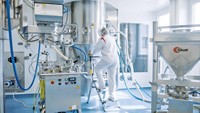Advertisement
Grab your lab coat. Let's get started
Welcome!
Welcome!
Create an account below to get 6 C&EN articles per month, receive newsletters and more - all free.
It seems this is your first time logging in online. Please enter the following information to continue.
As an ACS member you automatically get access to this site. All we need is few more details to create your reading experience.
Not you? Sign in with a different account.
Not you? Sign in with a different account.
ERROR 1
ERROR 1
ERROR 2
ERROR 2
ERROR 2
ERROR 2
ERROR 2
Password and Confirm password must match.
If you have an ACS member number, please enter it here so we can link this account to your membership. (optional)
ERROR 2
ACS values your privacy. By submitting your information, you are gaining access to C&EN and subscribing to our weekly newsletter. We use the information you provide to make your reading experience better, and we will never sell your data to third party members.
Business
A New Battlefield in Biologics
Having achieved capacity balance, contract service firms move into life-cycle management
by Rick Mullin
May 10, 2004
| A version of this story appeared in
Volume 82, Issue 19
Contract manufacturers of biopharmaceuticals say supply and demand for products made by both mammalian cell culture and microbial fermentation have reached a kind of delicate balance following several years of capacity buildup. Attention is now shifting to improving process efficiency and increasing yield in biologics manufacturing to keep up with a market that continues to grow rapidly.
Nick Shackley, vice president of sales and business development at Cambrex, addressed this shift in a recent presentation at the Chemists' Club in New York City. Shackley provided an overview of current projects that will bring hundreds of liters of new manufacturing capacity on-line over the next two years. He also illustrated the need for more capacity in the near term, given projections that growth in biopharmaceuticals, currently 15% annually, will outpace that of the overall pharmaceutical sector.

SHACKLEY NOTED that demand for biologics produced via mammalian cell culture will continue to outpace demand for microbial-produced materials. He attributes this discrepancy in part to the commercial success of complex, large-volume monoclonal antibodies, which can only be produced in mammalian cells.
According to Shackley, the stainless steel buildup of recent years is unsustainable. Rather than merely investing in additional capacity, contract producers will also need to beef up process design expertise. Improving efficiency will require producers to take "a holistic approach to process development at an early stage, based on strong science and experience."
Contract manufacturers across the sector agree that cost of goods and product life cycle are growing considerations as the biologics market matures. Clients, they say, are paying attention to effectively scaling up production rather than just pushing products through to proof-of-concept using the least expensive process feasible at the pilot scale.
Kevin Cox, vice president of biotechnology at Avecia, says his company's biopharmaceutical clients and their investors are becoming more sophisticated in regard to long-term process design. "Investors have changed focus from early-stage to later stage molecules," Cox says. "They come to us and ask, 'How robust is the supply chain? What effort has been put into addressing the appropriate scale of manufacture?' They are challenging us about whether we are putting the appropriate investment in ahead of time, or whether there are problems being stored up that could ultimately destroy value."
Beyond clients' cost concerns, Cox says, simply meeting future demand for biologics will keep producers focused on improving efficiency. But capacity is a difficult thing to gauge. According to Cox, capacity is now adequate for pilot- and large-scale production of both mammalian cell and microbial proteins, but it will be short in the midrange.
"This is a new development," Cox says. "Not long ago, everyone said we were generally short on capacity. A number of companies reacted very quickly to that." There was significant investment in early-stage production at the same time that a number of products failed in clinical trials, freeing up large-scale capacity, he says. "The middle is tight because no one has concentrated on that range," Cox says. "Yet it's the area most clients are interested in scaling up these days."
Mark Carver, head of biotechnology R&D at Avecia, points out that meeting capacity needs will require increasing the efficiency of cell cultures. This work is already under way, however, as the complexity of the pharmaceutical proteins going into production increases, he says.
Avecia, which is scaling up its microbial capacity in Billingham, England, has a nascent business in mammalian cell culture. Cox says the company is hoping to transfer its microbial process know-how into efficient process development in the mammalian cell arena and claims the company is in an ideal position to work with customers on early-phase mammalian cell development.
Cox says the industry's capacity balance is translating into slowed investment. "Not only have we not invested in large mammalian capacity," he says, "we've also been going stepwise on microbial." The firm has decided to hold off on installing a third 5,000-L vessel originally planned for Billingham.
At Lonza, a lead contract producer of mammalian cell culture biologics, there is a constant push to improve gene expression technology, cell screening, and purification in order to boost yields, says John R. Birch, chief scientific officer. The company has a proprietary glutamine synthetase gene expression system. "In our most recent work, we have been screening for highly producing cell lines and developing optimum media feeds," Birch says. "We've gotten in excess of 4 g per L of monoclonal antibody."
In the mid-1990s, Birch says, yields in mammalian cell batch systems were well under 1g per L. Only in recent years have a significant number of producers pushed into the 1- to 3-g-per-L range. "There is certainly more emphasis on process efficiency," he says. "But you don't benefit from process improvements immediately, because when you get to late-stage clinical trials, processes are locked in. It takes a few years for new process technology to work its way through to products being made at high volume."
Thomas Primiano, chief executive officer of Clonex Development, a Chicago-based biotech process engineering firm, explains that there are mechanical, chemical, and biological means of boosting production. Much of the focus is on staving off cell death, or apoptosis, generally accomplished through the addition of chemical agents such as glycine and caffeine, or through the addition of proteins that prolong cell life. Cell life can also be lengthened via genetic engineering with tumor suppressant genes, he says. Some of these methods can produce a fourfold yield increase, he adds.

HOWEVER, optimizing cell lines before they are designed into a process can produce even higher yields, Primiano maintains. Clonex, he says, has developed a proprietary means of triggering premature senescence in cells, stopping the process of mitosis and causing cells to grow larger: Mitochondria increase in number, secretory systems expand, and protein synthesis machinery expands, all of which accelerate the amount of protein produced by a cell.
"Most major companies go with an antiapoptotic approach, using chemical factors like glycine that can produce a similar effect," he says. "I think it's much simpler to engineer a cell line once and be able to use it."
Executives with major contract manufacturing firms contend that while chemical and biological apoptotic fixes are often applied to boost production, the companies are, in fact, working steadily on optimizing cell lines and pioneering more efficient gene expression systems.
Dow Chemical, for example, has developed a microbial gene expression technology based on Pseudomonas fluorescens, a high-expression bacterium that maintains the critical solubility and activity characteristics of the proteins it expresses. Nick Hyde, Dowpharma business director, says the system generally produces lower levels of metabolic by-products than Escherichia coli and other standard expression platforms, while increasing product purity and overall yield.
Patrick Lucy, business development leader for microbial proteins, says Dow calls on process design and genetic engineering capabilities from across the company. "Dow uses tools such as genomics and bioinformatics--typical drug discovery tools--to optimize the expression system for each customer. That is what differentiates Dow from our competitors. This is not an off-the-shelf protein. We customize these strains for optimal expression with our capabilities in San Diego, which are world class."
Indeed, sources agree that process design expertise and customization services are moving to the competitive forefront in biologics. "People discuss the capacity gap," Avecia's Carver says. "But there is a shortage of high-quality development capability out there. That has not been addressed by simply building loads of new facilities. It's relatively easy to raise tens of millions of dollars and put some stainless steel on the ground. It's much more difficult to have the right people on the ground. The industry is just waking up to this."
As it does, contract manufacturers will be called on to work more closely with customers, Cambrex's Shackley predicts. "A good contract manufacturing operation incorporates a modicum of consultancy into their business," he says. "You have to discuss options and determine what's worth exploring in order to improve productivity and get the cost of goods down."
Cox at Avecia agrees. "Some customers appreciate the need to address efficient process design up-front," he says. "Others with limited financing want it done quick and cheap. They have different expectations and desires. Where we add the most value is in taking on early-stage partners and working with them through their journey."
Avecia, like others, will move into the new competitive fray, leading with its pedigree, Cox says. "We have a quarter-century of process-developing experience in biologics," he says. "That's where we came from and the skill we bring to the market."








Join the conversation
Contact the reporter
Submit a Letter to the Editor for publication
Engage with us on Twitter